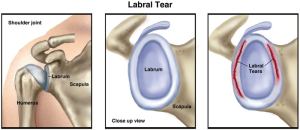The Labrum is a cuff-like piece of rubbery tissue (cartilage) that attaches to the rim of the shoulder socket. Its purpose is to keep the ball of the shoulder joint (called the Humeral Head) in place within the shoulder socket. (The shoulder is — like the hip — a ball and socket joint, but it’s a shallow socket that’s “deepened” and thus made more stable, by the Labrum.) When this fibrous cartilage cuff is called the Labrum Tear, it’s referred to as a Labral Tear. Labral Tear will impair proper shoulder movement, and you may experience symptoms such as
- An achy shoulder
- Pain when you attempt to perform certain movements involving the shoulder
- A “catch” within the shoulder when you move it, especially in an overhead motion
- a sense of instability in the shoulder

If you experience any or all of these symptoms, you may indeed have suffered a Labral Tear. In any case, it’s important to see your doctor to receive a proper diagnosis so that the appropriate treatment can begin. Even if you’re not aware of a specific injury, it’s important to know that various shoulder problems — including Labral Tears — can sometimes be a byproduct of aging as cartilage becomes more brittle.
Different Types of Labral Tears
There are actually a few different patterns that a labral tear of the shoulder can take. These are a SLAP Tear, a Bankart Tear, and a Posterior Tear.
- The SLAP Tear is commonly seen in athletes like baseball or tennis players who commonly use an overhead movement frequently in their sport. In this case, the Labral Tear occurs at the top of the socket where the Biceps Tendon attaches to the shoulder.
- A Bankart Tear usually occurs as the result of a dislocated shoulder — where the ball comes out of the joint and tears the Labrum. Once this type of tear occurs, it makes future shoulder dislocations more likely.
- A Posterior Tear is not as common as the SLAP or the Bankart Tear but can occur in a condition afflicting some athletes called Internal Impingement — a condition in which the Rotator Cuff and the Labrum are “pinched” together toward the back of the shoulder joint.
Diagnosis
A Labral Tear is not always easy to detect with standard x-rays, so if after examining your shoulder physically and asking questions, your doctor suspects a Labral Tear, he’ll probably order an MRI or a special MRI (called an MR Arthrogram)that includes the injection of dye to make the tear easier to see, however, even these more sophisticated MRI tests can sometimes miss small tears or even produce false-positive results.) In some cases, the only way to positively diagnose the condition is through arthroscopic surgery.

Treating a Labral Tear
The good news is that treating a Labral Tear doesn’t always involve surgery, though a particularly severe tear may. Usually, though, less invasive treatments show good results. These include
- restricting movement for a time
- working with a physical therapist to learn ways to use the shoulder without putting further stress on the damaged Labrum
- anti-inflammatory medication such as ibuprofen or Advil

What if You Need Surgery?
Arthroscopic surgery is generally the surgery of choice for a severe Labral Tear. During the surgery, which is performed through small incisions with tiny instruments, the doctor will examine the rim of the Labrum carefully to make sure that the shoulder is stable. If there is an injury to the Biceps Tendon, such as a tear, she may have to repair the tendon, but if the tear involves the rim only, she’ll simply repair the torn flap, anchor it back to the bone, and correct any associated problems. After surgery, you’ll see a physical therapist who will teach you the proper way to move and exercise your shoulder while you recover and heal.
If you’ve been diagnosed with a Labral Tear or are recovering from surgery to repair one, give Cawley Physical Therapy and Rehab a call at 570-208-2787 to start working with a doctor of physical therapy today!
PS: You can also email us, if you prefer, at cawleyptfrank@gmail.com

Looking for Relief today?? Click below to sign up for one of our limited Free Discovery Visits!

